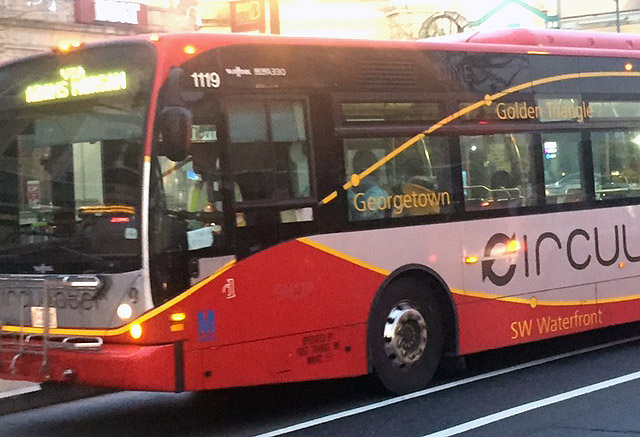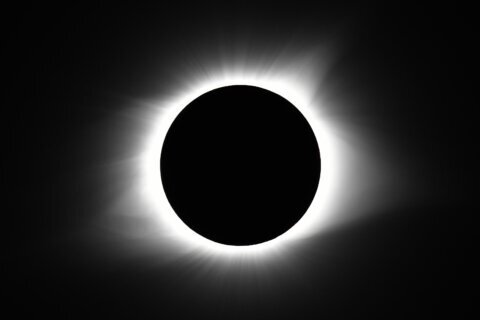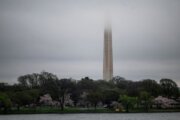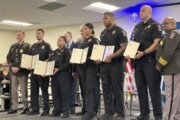Millions of people are expected to travel to witness the awe-inspiring total solar eclipse Monday. A WTOP Traffic reporter has some tips for those explorers headed toward the path of totality.
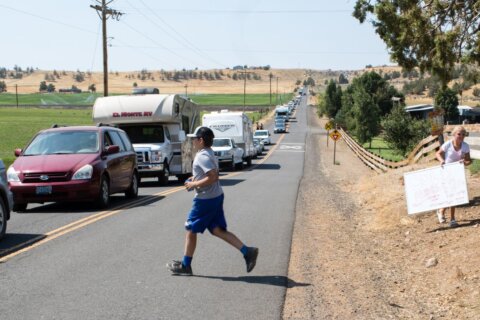
You can’t witness the solar eclipse in its full glory in the D.C. area, though a partial eclipse will be visible.
“It’ll be like a big pilgrimage, and many people will stop at nothing to experience a sacred solar event,” said WTOP Traffic reporter Dave Dildine.
He’s among the masses who are on a quest for a better view of the celestial phenomenon in the path of totality — which stretches across fifteen U.S. states from Texas to Maine.
“It is possible that millions of people will be driving in the same direction at the same time,” Dildine said. “There’s going to be a great migration taking place and whenever loads of people go to the same place at the same time, long lines will inevitably form.”
More on the solar eclipse:
- Montgomery Co. father planning 5-hour drive for ‘awe-inspiring’ view of eclipse
- What to know about next week’s total solar eclipse in the US, Mexico and Canada
- Not in the path of totality? You can still watch Monday’s total solar eclipse online
- Where to buy solar eclipse glasses as fakes and counterfeits emerge
In 2017, the first total solar eclipse in nearly a century swept coast to coast in the U.S. As far as lessons learned from that solar event: highways in the path of totality were “very congested” both during and after totality, Dildine said.
“If you think about how bad traffic is getting to like a Nats Phillies game, or a big concert at Jiffy Lube Live, amplify that for the population of multiple metro areas and then stretch that demand across a thin line,” Dildine said. “That’s what we’re talking about in 2017.”
Some eclipse-travelers sat in hourslong backups.
“Worse off were the travelers who wriggled into small confined areas like parks with limited access,” Dildine said.
Travel tips for eclipse
Dildine recommended drivers plan ahead to avoid some of that congestion.
“Try to give yourself multiple escape options near crossroads with capacity,” Dildine said. “Definitely arrive early and plan to leave late.”
At the very latest, he said D.C.-area residents should hit the road late Sunday.
“I think that it’s going to get awfully congested as you get closer and closer to the path of totality late Monday morning,” Dildine said.
And pack an overnight bag with essentials.
“It may sound dramatic but if you’re driving, bring a survival kit: bottled water, nonperishable food, a blanket, medication,” he said. “It’s possible that some people won’t get home Monday night and may have to spend the night in their car.”
The Federal Highway Administration recommended those in the path of totality avoid driving during the eclipse, which it said can cause “major traffic issues.” Here are some tips from the administration for those who have to drive:
- Headlights should be on
- Don’t take photos and drive — get off the highway to watch the eclipse (no, don’t pull onto the roadway’s shoulder)
The Federal Highway Administration and Dildine emphasized that eclipse glasses (approved by the American Astronomical Society) are necessary for safely taking in the view without permanently damaging your eyes. But, while it may seem obvious, they reminded drivers that you can’t operate a motor vehicle while wearing those opaque lenses.
“Don’t look directly at the sun while you’re driving,” Dildine added, chuckling.
In other travel lessons learned from 2017, Dildine is picking his destination with the weather forecast in mind, maybe New England or Missouri based on predicted cloud cover. Last time around, Dildine was “crestfallen” when his view in Missouri was snatched away at the last moment when a patch of clouds drifted in, he said.
“It covered the sun right when the moon slipped over the disk. The clouds lifted as totality ended,” Dildine said. “This is going to be a redo and we’re determined to get it right this year.”
What about driving in the DC area?
Even though the D.C. area isn’t in the path of totality, local transportation officials still expect congestion on area roads from those looking to watch the partial eclipse.
Virginia’s Department of Transportation will put message boards up on highways while the eclipse is visible to remind drivers to be safe, according to its spokeswoman, Jessica Cowardin.
“We’re encouraging folks to keep their eyes open and eyes on the road, not to wear their solar eclipse glasses while they’re driving,” Cowardin said. “Please don’t pull over on the side of the road. If you’re playing to watch the Eclipse, make sure you have a safe place to park.”
WTOP’s Grace Newton contributed to this report.
Get breaking news and daily headlines delivered to your email inbox by signing up here.
© 2024 WTOP. All Rights Reserved. This website is not intended for users located within the European Economic Area.


